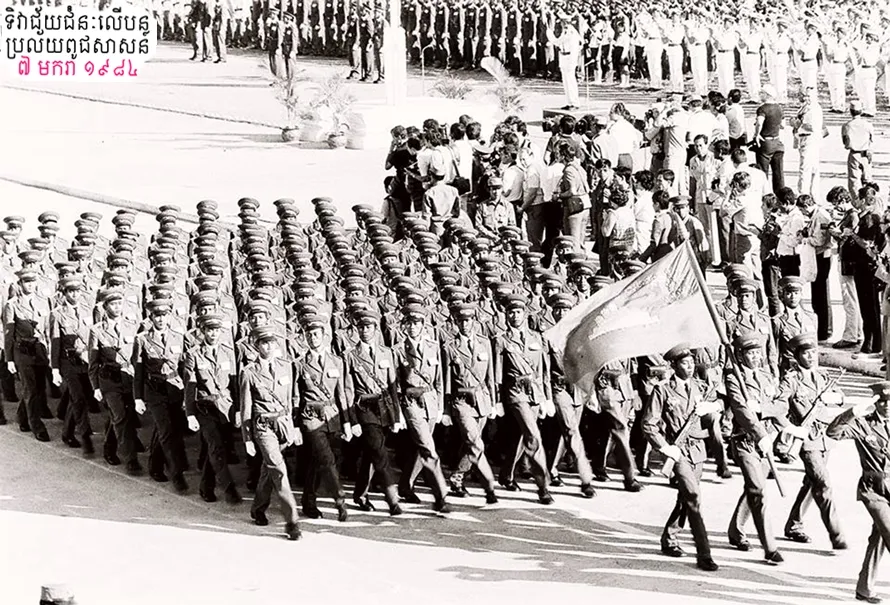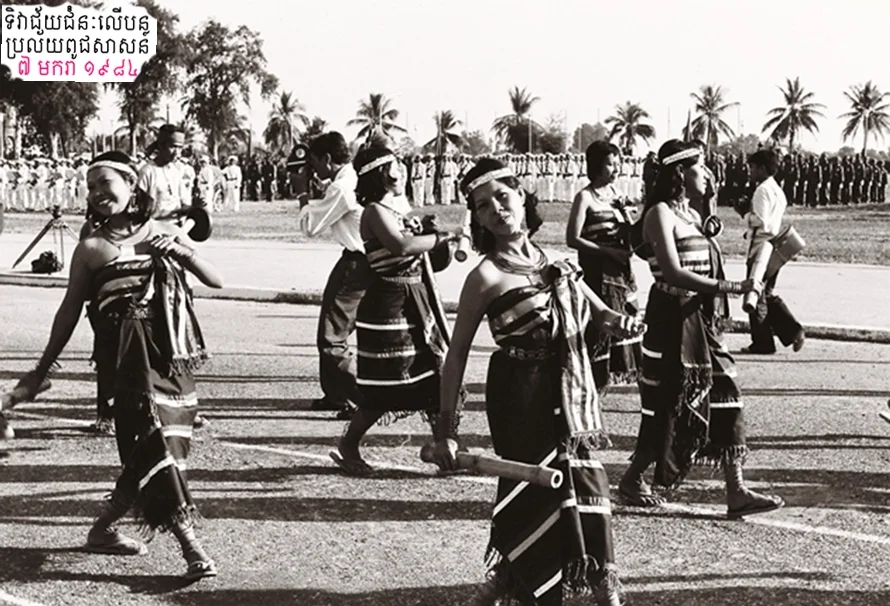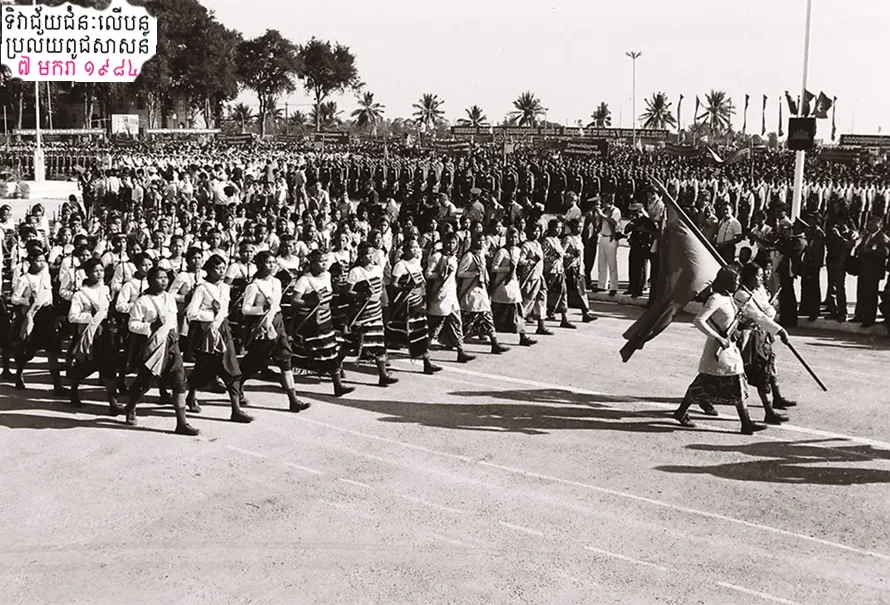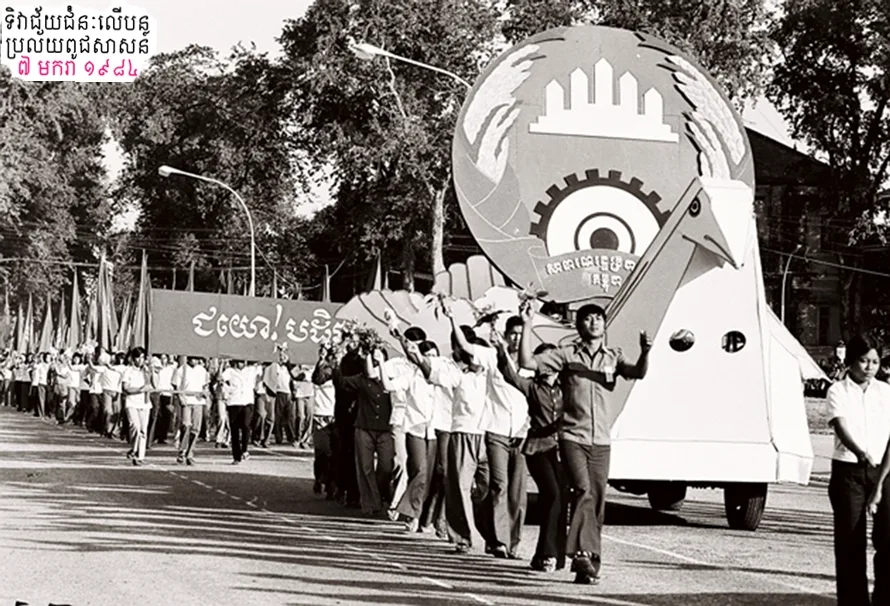1984 Chronology of Cambodian History
- Jan. 7, 1984 PRK Pres. Heng Samrin told foreign journalists that he welcomed Kampuchean peace initiatives but rejected idea of ASEAN peacekeeping force. Meanwhile, FM Hun Sen, at press conference, rejected any sort of reconciliation with Prince Sihanouk or Son Sann; and said there were 61,000 ethnic Chinese living in Kampuchea and 56,000 Vietnamese compared to 500,000 Vietnamese before 1975.
- Jan. 9, 1984 CGDK issued statement listing four instances of Vietnamese use of chemical weapons in Kampuchea, which killed seven people.
- Jan. 15, 1984 Prince Sihanouk arrived in Beijing from Pyongyang told journalists that he was prepared to talk with Soviet officials about Kampuchean problem.
- Jan. 17, 1984 Ukrainian Soviet Socialist Republic registered, with the UN, its objection to the ratification by DK of the International Convention on the Elimination of All Forms of Racial Discrimination.
- Jan. 20, 1984 Prince Sihanouk arrived in Bangkok from Beijing; he was received by his Vice-Pres. Khieu Samphan, PM Son Sann, Thai FM Siddhi Savetsila, ASEAN Ambassadors to Thailand, China, Pakistan, Brunei and North Korea. Speaking to reporters, the Prince said he was ready to pay visits to all the liberated zones inside Kampuchea under the control of the different movement, and that “there are no differences, no disputes among the three patriotic movements.” (FAB #3-4)
- an. 22, 1984 Prince Sihanouk met with Thai FM Siddhi Savetsila and senior officials of the Thai Foreign Ministry. Australian FM Hayden told journalists that FUNCINPEC and KPNLF would be allowed to open an office in Australia but would have neither diplomatic nor official status nor allowed to advocate violence.
- Jan. 23, 1984 Prince Sihanouk met and held meeting with his FUNCINPEC/ANS military leaders, cadres and oversea representatives. [Press Release] (FAB #3-4)
- Jan. 24, 1984 CGDK held its Council of Ministers meeting inside Kampuchea presided by Prince Sihanouk, attending by VP Khieu Samphan, PM Son Sann, Prince Ranariddh and the ministers of the coalition govt. (FAB #3-4)
- Jan. 25, 1984 Ethiopia registered, with the UN, its objection to the ratification by DK of the International Convention on the Elimination of All Forms of Racial Discrimination, “The Provisional Military Govt. of Socialist Ethiopia should like to reiterate that the Govt. of the PRK is the sole legitimate representative of the People of Kampuchea and such is alone has the authority to act on behalf of Kampuchea.” [9464]
- Jan. 26, 1984 Prince Sihanouk visited Phnom Malai, Khmer Rouge controlled area, to receive credentials of ambassadors of Yugoslavia and Egypt. Belgium joined Australia in urging Vietnam to refrain from mounting any dry season military sweep against guerilla-forces in Kampuchea. (FAB #3-4)
- Jan. 27, 1984 PRK and USSR signed transportation cooperation memorandum under which the Soviet would provide goods shipping by sea to Kampuchea. PRK Agriculture Minister Kong Samol and Vietnamese Minister of Marine Products signed 1984 fisheries cooperation agreement in Phnom Penh. Prince Sihanouk held talks at Laem Taem guesthouse with the Ambassadors of Malaysia, Indonesia, the Philippines and a senior Singaporean Embassy official. (FAB #3-4)
- Jan. 28, 1984 PRK FM Hun Sen departed Phnom Penh for Vientiane to attend the 8th Indochinese foreign ministers conference.
- Jan. 29, 1984 Prince Sihanouk and Princess Monique visited KPNLF’s camp of Banteay Ampil, receiving by CGDK PM/KPNLF Pres. Son Sann. (FAB #3-4) Vietnam registered, with the UN, its objection to the ratification by DK of the International Convention on the Elimination of All Forms of Racial Discrimination. [9464]Jan. 30, 1984 Prince Sihanouk and Princess Monique visited the FUNCINPEC/ANS camp of Tatum (Green Hill). (FAB #3-4)
- Feb. 1, 1984 Prince Sihanouk and Princess Monique were granted an audience with King and Queen of Thailand at Phu Phing Palace in Chiang Mai. (FAB #3-4)
- Feb. 2, 1984 Belgian FM Leo Tindemans told news reporters in Jakarta that his country totally supports Kampuchean resistance movement and ASEAN’s position on Kampuchean issue. Prince Sihanouk accompanied by Prince Ranariddh called on Thai PM Prem Tinsulanonda, discussing the Kampuchean situation. Prince Sihanouk also told Thai PM that Vietnamese were changing the frontier maps to reflect the annexation of a piece of Kampuchean territory known as the “Parrot’s Beak”. (FAB #3-4) Feb. 5, 1984 Soviet deputy FM Mikhail Kapitsa arrived in Phnom Penh for a 4-days visit. He met with Pres. Heng Samrin, PM Chan Sy and FM Hun Sen. CGDK delegation led by Prince Sihanouk arrived in Kuala Lumpur to begin a 10-days visit to Malaysia. (FAB #3-4)
- Feb. 6, 1984 Prince Sihanouk met and discussed Kampuchean problem with Malaysian PM Mahathir Mohammed. Earlier, Prince Sihanouk and Princess Monique were received in audience by the Malaysian King and Queen. (FAB #3-4)
- Feb. 9, 1984 ANS Commander Lt. Gen. Pak Meenakanit told reporters that 18 of his troops suffered from gas attack. He said the yellow gas, contained in mortar shells and fired from grenade launchers, caused the soldiers to faint, have difficulties in breathing and hamper their vision. (FAB #3-4)
- Feb. 11, 1984 KPRP General Secretary Heng Samrin departed Phnom Penh for Moscow, leading delegate to attend funeral of CPSU Secretary General Yuri Andropov.
- Feb. 14, 1984 CGDK delegation led by Prince Sihanouk arrived in Singapore to begin a 6-days visit. (FAB #3-4)
- Feb. 15, 1984 CGDK delegation held talks with Singaporean FM S. Dhanabalan, discussing recent diplomatic and military activities of the Kampuchean resistance. (FAB #3-4)
- Feb. 18, 1984 Ceremonies were held in Phnom Penh marking fifth anniversary of signing of Kampuchea-Vietnam Treaty of Peace, Friendship and Cooperation.
- Feb. 20, 1984 PRK and Vietnam signed in Phnom Penh a 1984 Protocol of Educational Cooperation, in which Vietnam was to help compile and publish teaching materials and provide study grants to Kampuchean students. CGDK delegation led by Prince Sihanouk arrived in Jakarta to begin a 2-weeks visit to Indonesia. (FAB #3-4)
- Feb. 21, 1984 Prince Sihanouk met with Indonesian Pres. Soharto, who assured the Prince of Indonesia continue support of the CGDK. (FAB #3-4)
- Feb. 26, 1984 PRK and GDR (East German) signed a public health cooperation plan for 1984-86, in which GDR would assist Kampuchea in health care training and administrative practices.
- Feb. 29, 1984 The Govt. of Vietnam registered, with the UN, its objection to the ratification by DK of the International Convention on the Elimination of All Forms of Racial Discrimination, “The Govt. of the SRV considers that only the Govt. of the PRK, which is the sole genuine and legitimate representative of the Kampuchean people, is empowered to act in their behalf to sign, ratify or accede to international conventions.”
- March 4, 1984 An Italian embassy official in Bangkok told news reporters that his govt. had approved $500,000 in humanitarian aid to Kampuchean resistance forces of Prince Sihanouk and Son Sann. He added the aid would be extended through UN Border Relief Organization.
- March 5, 1984 Vietnamese army newspaper (Nhan Dan) accused Singapore of arming the Kampuchean resistance and of maintaining tension in Southeast Asia. (FAB #3-4)
- March 6, 1984 National Mekong Committee of three Indochinese countries opened 7th conference in Phnom Penh. Delegations were headed by Kong Samol - Kampuchea Agriculture Minister, Dinh Gia Khanh - Vietnam Deputy Minister of Water Conservancy, and Somphavan Inthavon - Loas Vice-Chairman of Planning Committee. The conference called for Kampuchea to be legitimate member of International Mekong Committee if there was to be effective exploitation of lower Mekong. CGDK delegation led by Prince Sihanouk arrived in Manila to begin a weeklong visit to the Philippines. (FAB #3-4)
- March 9, 1984 CGDK PM Son Sann arrived in Singapore for a 6-days visit, telling news reporters that he was optimistic about Kampuchea’s future since “now it is not a question of whether Vietnamese troops will leave, but when.”
- March 12, 1984 The Govt. of Czechoslovakia registered, with the UN, its objection to the ratification by DK of the International Convention on the Elimination of All Forms of Racial Discrimination.
- March 20, 1984 CGDK Pres. Prince Sihanouk returned to Phnom Malai to accept credentials of Malaysian ambassador Datuk Ismail bin Mohamed.
- March 21, 1984 Japanese FM Shintaro Abe said Prince Sihanouk would make a weeklong visit to Japan starting May 30 at the invitation of Japanese govt. This would be Prince Sihanouk’s first trip to Japan since an unofficial visit in 1961. (FAB #3-4)
- March 22, 1984 Thai Army Supreme Command spokesman said there were strong indications that Vietnamese troops in Kampuchea plan to use chemical warfare to wipe out resistance force.
- April 6, 1984 UN Special envoy in charge of humanitarian aid to Kampuchea, Tatsuro Kunugi, left Phnom Penh after 8-days visit.
- April 8, 1984 PRK FM Hun Sen stopped in Moscow en-route home from African tour.
- April 13, 1984 PRK Deputy FM Kong Korm told visiting Swedish journalist that both Prince Sihanouk and Son Sann can return to Kampuchea, even run for office in an election it they accept the present Constitution. He also added that major condition for Prince Sihanouk’s return was that he breaks with Khmer Rouge.
- April 18, 1984 PRK Foreign Ministry issued a 3-points statement regarding refugees in Thai-Kampuchean border area, charging that the refugees were furthering Chinese aims, that Thailand’s dealing with them violate international law, and that PRK was willing to hold either direct or indirect talks with Thailand on the problem.
- April 26, 1984 German Democratic Republic (East Germany) registered, with the UN, its objection to the ratification by DK of the International Convention on the Elimination of All Forms of Racial Discrimination, “The GDR does not recognize the so-called CGDK and therefore regards its instrument of ratification concerning the Convention as being without legal force. The only legitimate representative of the people of Kampuchea is the Govt. of the PRK.”
- May 8, 1984 Fourteen Thai captured during combat along Thai-Kampuchean border were presented at press conference in Phnom Penh by KPRAF Deputy Chief of Staff Tea Banh.
- May 15, 1984 The Govt. of the French Republic registered, with the UN, its objection to the ratification by DK of the International Convention on the Elimination of All Forms of Racial Discrimination, “The Govt. of the French Republic, which does not recognize the CGDK, declares that the instrument of DK of the International Convention…is without effect.”
- May 20, 1984 A national “Day of Hate” was proclaimed by the PRK to mark start of “Pol Pot genocide” on May 20, 1975. Ceremonies and observances were ordered nationwide.
- May 31, 1984 Prince Sihanouk told Japanese PM Nakasone that he was ready to head a 4-way coalition interim govt., which could stage elections to name permanent govt. The only condition was that PRK stop acting as a spokesman for Hanoi. Prince Sihanouk also asked Japan to name an ambassador to CGDK.
- June 1, 1984 The first Indochina Foreign Trade conference convened in Phnom Penh. Delegations were headed by ministers of trade: Tang Saroem of Kampuchea, Le Khac of Vietnam and Vanthong Sengmuang of Loas.
- June 7, 1984 The Govt. of Mongolia registered, with the UN, its objection to the ratification by DK of the International Convention on the Elimination of All Forms of Racial Discrimination.
- June 14, 1984 Japan and Thailand, at working level consultations in Bangkok, agreed to promote effort to bring about comprehensive solution to Kampuchea problem. Japanese Deputy FM Toshijiro Nakajima pledged his country’s full backing for ASEAN position supporting CGDK.
- June 24, 1984 Ceremonies were held for some 3,000 Vietnamese troops departing Kampuchea for home; the troops was part of 10,000 Hanoi said will leave during 1984.
- July 2, 1984 The 2nd Kampuchean Monks Congress convened in Phnom Penh for a 2-days session presided by National Assembly Chairman Chea Sim.
- July 11, 1984 Prince Sihanouk told newsmen his position on settlement of the Kampuchean problem was through an all-party international conference. He implied this had Beijing’s endorsement.
- July 16, 1984 A high-level PRK delegation, headed by PM Chan Sy, departed Phnom Penh on tour of socialist countries in search of economic aid. CGDK PM Son Sann said, in an interview, that China was CGDK’s sole arms supplier only because France and other countries would not supply military hardware to his resistance group.
- July 26, 1984 PRK and Bulgaria signed an agreement concerning a non-reimbursable assistance granted to Kampuchea in the fields of education, culture and sport for the period 1985-90. [Agreement in English French Khmer PRK FM Hun Sen told an interviewer that Prince Sihanouk and Son Sann could plan a political role in Cambodia if they agree to return and to recognize the new constitution. But he ruled out their inclusion in a coalition govt.
- Aug. 1, 1984 The 9th Plenum of the KPRP convened in Phnom Penh for a 4-days session under the chairmanship of Party Secretary General Heng Samrin. Six resolutions were adopted dealing with economic, social and foreign affairs. The Plenum also issued a directive called “Guideline for the Central Propaganda and Education Commission,” setting forth an ambitious domestic propaganda campaign to be implemented by the National Assembly. KPNLF launched a campaign called Sponsor-a-Guerrilla Program, in which individuals abroad were solicited for a donation of $40 to provide basic personal equipment for one resistance fighter such as uniform, hammock, knapsack, etc. Literature stressed money would not be used for weapons purchase. Prince Sihanouk and Egypt issued joint communiqué in Cairo at the end of Prince Sihanouk’s 5-days visit. It was a strong endorsement of Kampuchea resistance cause but contains no indication that Egypt will supply weapons to the CGDK as rumor.
- Aug. 3, 1984 Australian PM Bill Hayden left Bangkok after 4-days of discussions with Thai officials, chiefly about Kampuchea. He told a press conference Australia had no plans to resume economic aid to Vietnam, stressed the importance of ASEAN unity and said Hanoi had not answered his suggestion for an international conference on Kampuchea in Canberra. AFP reported two former high-ranking officials of DK had defected. They were Thiounn Thioum, former Economy and Finance Minister and Keat Chhun, former official in Prime Minister’s office with ministerial rank.
- Aug. 4, 1984 CGDK Vice-Pres. Khieu Samphan arrived in Mexico City for UN conference on population. He met with ASEAN diplomats during the stay.
- Aug. 8, 1984 Prince Sihanouk met with French Pres. Francois Mitterand for 45 minutes in Paris. Following the meeting, the two announced that they would meet twice a year of discuss Kampuchea matters.
- Aug. 14, 1984 Prince Sihanouk at press conference in Oslo, Norway, called for creation of coalition govt. in Kampuchea to include supporters of the PRK.
- Sept. 8, 1984 Chairman of the International Conference on Kampuchea, former Austrian FM Willibald Pahr, told news conference in Bangkok that Hanoi in four years had settled some 500,000 Vietnamese in Kampuchea, in addition to the 180,000 PAVN. Kampuchea population was estimated between six to seven millions.
- Sept. 12, 1984 Willibald Pahr, chairman of the International Commission of Kampuchea, proposed to demilitarized Angkor area. Phnom Penh rejected the idea citing it would be used as sanctuary by the resistance, ASEAN said the idea should be explored but noncommittal; Hanoi and CGDK made no comment.
- Sept. 23, 1984 Prince Sihanouk and Son Sann met with US Pres. Reagan in New York, following President’s address to UN General Assembly. A spokesman said Reagan restated US policy on Kampuchea: a political settlement that includes withdrawal of Vietnamese troops from Kampuchea.
- Sept. 28, 1984 Prince Sihanouk, Khieu Samphan and Son Sann arrived in Beijing for meetings with Chinese officials and to attend the PRC 35th anniversary.
- Oct. 11, 1984 PRK Information and Culture Minister Chheng Phon rejected proposal by Willibald Pahr, chairman of the International Conference on Kampuchea, to demilitarize Angkor area. CGDK accepted the proposal.
- Oct. 15, 1984 PRK and USSR signed in Moscow a protocol on exchange of ratification instruments for consular agreement.
- Oct. 17, 1984 UN General Assembly adopted without vote the recommendation of its Credentials Committee to seat CGDK. PRK Education Minister Pen Novouth sent telegram to UN-sponsored conference on education in Geneva, protesting presence of CGDK delegation.
- Oct. 19, 1984 PRK and Hungary signed in Budapest a Protocol on 1985 goods exchange, in which Kampuchea would trade agricultural products for Hungarian chemicals, electric equipment and fabrics.
- Oct. 22, 1984 Hungarian Industry Ministry delegation arrived in Phnom Penh for a visit. Delegation of Philippine women departed Phnom Penh after 5-days visit.
- Oct. 29, 1984 CGDK Pres. Prince Sihanouk delivered speech to UN General Assembly denouncing Vietnam invasion and occupation of Kampuchea.
- Oct. 30, 1984 The UN General Assembly again voted in favor of a resolution A/RES/39/5 calling for a withdrawal of Vietnamese forces from Cambodia. The votes were 110 to 22 with 18 abstentions.
- Nov. 1, 1984 PRK Pres. Heng Samrin and FM Hun Sen left Phnom Penh for New Delhi to attend Indira Gandhi funeral.
- Nov. 22, 1984 Prince Ranariddh, ANS commander, attended opening of FUNCINPEC office in Canberra and held talks with Australian foreign minister officials. He calls for both China and Vietnam to allow Kampuchea to become neutral.
- Dec. 12, 1984 New York based Lawyer Committee for International Human Rights charged that the Phnom Penh govt. routinely tortured political prisoners and said Vietnamese govt. officials were involved in the arrest and torture of Cambodians.
- Dec. 24, 1984 The US Congressional delegation headed by Rep. Stephen Solarz arrived in Phnom Penh for talks. The delegation met with PRK FM Hun Sen.
- Dec. 25, 1984 The Vietnamese forces occupying Cambodia launched an offensive against rebel strongholds along the Cambodian-Thai border. The attack began at dawn with tank and artillery fires. The following day Vietnamese troops overran Rithisen, KPNLF's largest camp, forcing thousands of its inhabitants to flee into Thailand.
- Dec. 31, 1984 Radio Phnom Penh announced the death of the PRK PM Chan Sy. The Premier, who was appointed to the premier post in Feb. 1982, died in Moscow, USSR. He was there for medical treatment. He was believed to have died some days before the announcement. Other events happened in 1984 Haing Ngor won an Oscar-award for Best Supporting Actor in "The Killing Fields".
អ៊ុន សុវណ្ណា is with តា ព្រហ្ម and

 ទិវារម្លឹកខួបទី ៥ ថ្ងៃជ័យជម្នះ ៧មករា
ទិវារម្លឹកខួបទី ៥ ថ្ងៃជ័យជម្នះ ៧មករា 

 អតីតសិស្សសាលាបាក់ទូកទាំងអស់គ្នានៅចងចាំទេ? កាលថ្ងៃទី៧ ខែមករា ឆ្នាំ១៩៨៤ មានប្រារព្ធពិធីបុណ្យធំថ្ងៃជ័យជម្នះនៅមុខវាំង ដោយមានក្បួនព្យុហយាត្រាដ៏វែងរាប់គីឡូម៉ែត្រ មកដល់ឆ្នាំ២០២៤នេះ គឺរយៈពេល៤០ឆ្នាំហើយ..!
អតីតសិស្សសាលាបាក់ទូកទាំងអស់គ្នានៅចងចាំទេ? កាលថ្ងៃទី៧ ខែមករា ឆ្នាំ១៩៨៤ មានប្រារព្ធពិធីបុណ្យធំថ្ងៃជ័យជម្នះនៅមុខវាំង ដោយមានក្បួនព្យុហយាត្រាដ៏វែងរាប់គីឡូម៉ែត្រ មកដល់ឆ្នាំ២០២៤នេះ គឺរយៈពេល៤០ឆ្នាំហើយ..! មិត្តហ្វេសប៊ុកណាខ្លះបានចូលរួមក្នុងពិធីហ្នឹងដែរ..?
មិត្តហ្វេសប៊ុកណាខ្លះបានចូលរួមក្នុងពិធីហ្នឹងដែរ..? កាលនោះយើងខ្ញុំរៀនត្រៀមប្រលងឌីប្លូមនៅថ្នាក់ទី ៧ញ«7J» ឆ្នាំសិក្សា ១៩៨៣-១៩៨៤ នៃសាលាបាក់ទូកកម្រិតសិក្សាទី ២។ កាលនោះខាងសាលាតម្រូវឲ្យយើងរៀបចំហាត់សមឈរ ជាកង ជាផែនសាកល្បងនៅក្នុងបរិវេណសាលា, ប្រធានផែនរបស់យើងកាលនោះរៀននៅថ្នាក់ទី១០(បាក់ឌុបជំនាន់ទី១នៅបាក់ទូក) ឈ្មោះ នរ័ត្ន..។
កាលនោះយើងខ្ញុំរៀនត្រៀមប្រលងឌីប្លូមនៅថ្នាក់ទី ៧ញ«7J» ឆ្នាំសិក្សា ១៩៨៣-១៩៨៤ នៃសាលាបាក់ទូកកម្រិតសិក្សាទី ២។ កាលនោះខាងសាលាតម្រូវឲ្យយើងរៀបចំហាត់សមឈរ ជាកង ជាផែនសាកល្បងនៅក្នុងបរិវេណសាលា, ប្រធានផែនរបស់យើងកាលនោះរៀននៅថ្នាក់ទី១០(បាក់ឌុបជំនាន់ទី១នៅបាក់ទូក) ឈ្មោះ នរ័ត្ន..។ នៅល្ងាចថ្ងៃទី ០៦ ខែមករា ឆ្នាំ ១៩៨៤ ខាងសាលាឲ្យពួកយើងមកជួបជុំគ្នានៅក្នុងបរិវេណសាលាបាក់ទូក ដោយមានបាឡូសម្រាប់ដាក់ ខោអាវឯកសណ្ឋានសិស្សអាវស, ខោពណ៌ទឹកប៊ិចចាស់ទុកផ្លាស់ប្ដូរ កម្រាលក្រាលដេក ភួយដណ្ដប់ដេកយប់ និងខ្ចប់បាយម្ហូប ទឹក សម្រាប់ទុកបរិភោគពេលល្ងាចរៀងៗខ្លួន។
នៅល្ងាចថ្ងៃទី ០៦ ខែមករា ឆ្នាំ ១៩៨៤ ខាងសាលាឲ្យពួកយើងមកជួបជុំគ្នានៅក្នុងបរិវេណសាលាបាក់ទូក ដោយមានបាឡូសម្រាប់ដាក់ ខោអាវឯកសណ្ឋានសិស្សអាវស, ខោពណ៌ទឹកប៊ិចចាស់ទុកផ្លាស់ប្ដូរ កម្រាលក្រាលដេក ភួយដណ្ដប់ដេកយប់ និងខ្ចប់បាយម្ហូប ទឹក សម្រាប់ទុកបរិភោគពេលល្ងាចរៀងៗខ្លួន។ ពេលទៅដល់សាលា ប្រធានក្រុមឆែកបាឡូគ្រប់សិស្សទាំងអស់គ្នា ខ្លាចក្រែងមានលាក់អាវុធគ្រឿងផ្ទុះខុសច្បាប់។
ពេលទៅដល់សាលា ប្រធានក្រុមឆែកបាឡូគ្រប់សិស្សទាំងអស់គ្នា ខ្លាចក្រែងមានលាក់អាវុធគ្រឿងផ្ទុះខុសច្បាប់។ បន្ទាប់មក ក្រុមយើងធ្វើដំណើរដោយថ្មើរជើងពីសាលាបាក់ទូក រហូតដល់មុខសណ្ឋាគារកាំបូឌីយ៉ាណា ដែលបោះបង់ចោល។
បន្ទាប់មក ក្រុមយើងធ្វើដំណើរដោយថ្មើរជើងពីសាលាបាក់ទូក រហូតដល់មុខសណ្ឋាគារកាំបូឌីយ៉ាណា ដែលបោះបង់ចោល។ ពួកយើងដេកនៅទីនោះមួយយប់ ដោយដេកហាលវាលគ្មានដំបូលជ្រកទេ គឺដេកនៅជើងទំនប់តូចមួយសម្រាប់ការពារទឹកជំនន់ទន្លេកុំឲ្យច្រាលចូលមកក្រុងភ្នំពេញ។ កាលនោះនៅពេលយប់មានឡានស៊ីទែនផលិតនៅសហភាពសូវៀតដឹកទឹកមកឲ្យពួកយើងប្រើ តែពួកយើងត្រូវមានប៊ីដុងរៀងៗខ្លួន ដើម្បីដាក់ទឹកទុកផឹក និងទុកលុបលាងមុខនៅពេលព្រឹក។ ពេលដេកយប់ដោយនៅជិតមាត់ទន្លេចតុម្មុខមានខ្យល់បក់ខ្លាំង និងរងាខ្លាំងណាស់។ ដោយសារតែមានសិស្សមកពីសាលាផ្សេងៗច្រើននោះ នាំពួកគេបន្ទោបង់ចោលពាសវាល ខ្លះដើរជាន់លាមក ខ្លះពេលយប់មមើមមាយ ក៏នោមច្រាសលើក្បាលគេកំពុងដេកក្បាលកោយក្បាលនៅជើងទំនប់ ដោយយប់ងងឹតគ្មានភ្លើងអគ្គិសនីបំភ្លឺផង។
ពួកយើងដេកនៅទីនោះមួយយប់ ដោយដេកហាលវាលគ្មានដំបូលជ្រកទេ គឺដេកនៅជើងទំនប់តូចមួយសម្រាប់ការពារទឹកជំនន់ទន្លេកុំឲ្យច្រាលចូលមកក្រុងភ្នំពេញ។ កាលនោះនៅពេលយប់មានឡានស៊ីទែនផលិតនៅសហភាពសូវៀតដឹកទឹកមកឲ្យពួកយើងប្រើ តែពួកយើងត្រូវមានប៊ីដុងរៀងៗខ្លួន ដើម្បីដាក់ទឹកទុកផឹក និងទុកលុបលាងមុខនៅពេលព្រឹក។ ពេលដេកយប់ដោយនៅជិតមាត់ទន្លេចតុម្មុខមានខ្យល់បក់ខ្លាំង និងរងាខ្លាំងណាស់។ ដោយសារតែមានសិស្សមកពីសាលាផ្សេងៗច្រើននោះ នាំពួកគេបន្ទោបង់ចោលពាសវាល ខ្លះដើរជាន់លាមក ខ្លះពេលយប់មមើមមាយ ក៏នោមច្រាសលើក្បាលគេកំពុងដេកក្បាលកោយក្បាលនៅជើងទំនប់ ដោយយប់ងងឹតគ្មានភ្លើងអគ្គិសនីបំភ្លឺផង។ រដ្ឋមិនអនុញ្ញាតឲ្យគេយកអាហារនំចំណីទៅលក់ដូរនៅម្ដុំនោះទេ ដើម្បីសុវត្ថិភាពពេលបុណ្យនោះ។
រដ្ឋមិនអនុញ្ញាតឲ្យគេយកអាហារនំចំណីទៅលក់ដូរនៅម្ដុំនោះទេ ដើម្បីសុវត្ថិភាពពេលបុណ្យនោះ។ ព្រឹកព្រហាមថ្ងៃទី៧ ខែមករា ឆ្នាំ១៩៨៤ ក្រុមពួកយើង មិនបានទទួលទានអាហារពេលព្រឹកនោះទេ។ ពួកយើងត្រូវគេចាត់តាំងឱ្យទៅឈរនៅមុខវាំង តែចំខាងក្រោយអគាររណសិរ្ស ដោយស្លៀកពាក់ឯកសណ្ឋានសិស្ស «អាវស ខោទឹកប៊ិចចាស់»។ គេតម្រូវឲ្យសិស្សកាន់កូនទង់ជាតិ ជាមួយផ្កាធ្វើពីក្រដាស, សិស្សខ្លះកាន់បដាពាក្យ ដូចជា « ជ័យឃោសផ្សេងៗ និងពាក្យស្លោកបដិវត្ត ដូចជា ៖ ស៊ូស្គមជាកិត្តិយស កុំឱ្យដុះក្បាលពោះ ដោយការបំផ្លាញជាតិ, ផ្ចាញ់ពាលដោយប្រើបញ្ញា ផ្ចាញ់បនប្រតិកិយា ដោយប្រើឧបាយកល...»។
ព្រឹកព្រហាមថ្ងៃទី៧ ខែមករា ឆ្នាំ១៩៨៤ ក្រុមពួកយើង មិនបានទទួលទានអាហារពេលព្រឹកនោះទេ។ ពួកយើងត្រូវគេចាត់តាំងឱ្យទៅឈរនៅមុខវាំង តែចំខាងក្រោយអគាររណសិរ្ស ដោយស្លៀកពាក់ឯកសណ្ឋានសិស្ស «អាវស ខោទឹកប៊ិចចាស់»។ គេតម្រូវឲ្យសិស្សកាន់កូនទង់ជាតិ ជាមួយផ្កាធ្វើពីក្រដាស, សិស្សខ្លះកាន់បដាពាក្យ ដូចជា « ជ័យឃោសផ្សេងៗ និងពាក្យស្លោកបដិវត្ត ដូចជា ៖ ស៊ូស្គមជាកិត្តិយស កុំឱ្យដុះក្បាលពោះ ដោយការបំផ្លាញជាតិ, ផ្ចាញ់ពាលដោយប្រើបញ្ញា ផ្ចាញ់បនប្រតិកិយា ដោយប្រើឧបាយកល...»។ ពេលចប់កម្មវិធីថ្លែងសន្ទរកថារបស់អគ្គលេខាធិការមជ្ឈិមបក្សកុម្មុយនិស្តកម្ពុជានៅម៉ោង១០ កម្មវិធីបន្ទាប់គឺមានហែក្បួនព្យុហយាត្រាដ៏វែងអន្លាយគ្រប់ក្រសួងមន្ទីរ..។
ពេលចប់កម្មវិធីថ្លែងសន្ទរកថារបស់អគ្គលេខាធិការមជ្ឈិមបក្សកុម្មុយនិស្តកម្ពុជានៅម៉ោង១០ កម្មវិធីបន្ទាប់គឺមានហែក្បួនព្យុហយាត្រាដ៏វែងអន្លាយគ្រប់ក្រសួងមន្ទីរ..។ កាលនោះខ្ញុំចាំថា ផែនក្រសួងសុខាភិបាល មាន១ក្រុម និស្សិតពេទ្យនៃមហាវិទ្យាល័យ វេជ្ជាសាស្រ្ត ឱសថសាស្រ្ត ទន្តសាស្រ្ត ស្លៀកឯកសណ្ឋានអាវប្ល៊ូពណ៌ស ពាក់មួក ពួកគេដើរក្បួនព្យុហយាត្រាក្នុងទំរង់ជាសឺរ៉ាំងចាក់ថ្នាំ ដែលក្រុមនិស្សិតស្រីៗ ដើរជាតួសឺរ៉ាំង-ម្ជុល ឯក្រុមនិស្សិតប្រុសៗ ដើរជាពីស្តុងសឺរ៉ាំង..
កាលនោះខ្ញុំចាំថា ផែនក្រសួងសុខាភិបាល មាន១ក្រុម និស្សិតពេទ្យនៃមហាវិទ្យាល័យ វេជ្ជាសាស្រ្ត ឱសថសាស្រ្ត ទន្តសាស្រ្ត ស្លៀកឯកសណ្ឋានអាវប្ល៊ូពណ៌ស ពាក់មួក ពួកគេដើរក្បួនព្យុហយាត្រាក្នុងទំរង់ជាសឺរ៉ាំងចាក់ថ្នាំ ដែលក្រុមនិស្សិតស្រីៗ ដើរជាតួសឺរ៉ាំង-ម្ជុល ឯក្រុមនិស្សិតប្រុសៗ ដើរជាពីស្តុងសឺរ៉ាំង.. គឺលោកអ៊ំព្រឹទ្ធបុរសសាលាពេទ្យ ម៉ី សាមឌី ជាអ្នកមានគំនិតឲ្យដើររបៀបនេះ។
គឺលោកអ៊ំព្រឹទ្ធបុរសសាលាពេទ្យ ម៉ី សាមឌី ជាអ្នកមានគំនិតឲ្យដើររបៀបនេះ។ ពួកយើងរំសាយ មកយកអីវ៉ាន់ដេកយប់នៅមុខសណ្ឋាគារកាបូឌីយ៉ាណាកន្លែងយើងដេកកាលពីយប់ និងត្រលប់ទៅផ្ទះវិញរៀងៗ ខ្លួន..។
ពួកយើងរំសាយ មកយកអីវ៉ាន់ដេកយប់នៅមុខសណ្ឋាគារកាបូឌីយ៉ាណាកន្លែងយើងដេកកាលពីយប់ និងត្រលប់ទៅផ្ទះវិញរៀងៗ ខ្លួន..។ ថ្ងៃចន្ទទី ៩ ខែមករា ឆ្នាំ១៩៨៤, ខាងសាលាកោះហៅសិស្សមករៀបចំជាកង ជាផែនឡើងវិញ និងចែកប្រាក់ឱ្យសិស្សដែលបានចូលរួមឈរនៅមុខវាំង ម្នាក់ៗទទួលបាន ២០រៀល, ប្រធានកង និងប្រធានផែនបានទទួលប្រាក់ ៥០រៀល លោកគ្រូអ្នកគ្រូដែលទៅចូលជាមួយសិស្ស ក៏បានប្រាក់ដែរ តែបានច្រើនជាងសិស្ស...!
ថ្ងៃចន្ទទី ៩ ខែមករា ឆ្នាំ១៩៨៤, ខាងសាលាកោះហៅសិស្សមករៀបចំជាកង ជាផែនឡើងវិញ និងចែកប្រាក់ឱ្យសិស្សដែលបានចូលរួមឈរនៅមុខវាំង ម្នាក់ៗទទួលបាន ២០រៀល, ប្រធានកង និងប្រធានផែនបានទទួលប្រាក់ ៥០រៀល លោកគ្រូអ្នកគ្រូដែលទៅចូលជាមួយសិស្ស ក៏បានប្រាក់ដែរ តែបានច្រើនជាងសិស្ស...! វេជ្ជ. អ៊ុន សុវណ្ណា
វេជ្ជ. អ៊ុន សុវណ្ណា




























































No comments:
Post a Comment